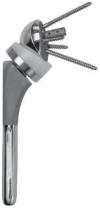Computer-Assisted Navigation in Reverse Shoulder Arthroplasty: Surgical Experience and Clinical Outcomes
- PMID: 38731041
- PMCID: PMC11084768
- DOI: 10.3390/jcm13092512
Computer-Assisted Navigation in Reverse Shoulder Arthroplasty: Surgical Experience and Clinical Outcomes
Abstract
Background: The primary cause of medium- to long-term complications in reverse shoulder arthroplasty (RSA) is the failure of the glenoid component. The purpose of this study was to evaluate both the achievement of planning through computer-assisted navigation and the clinical outcomes at a minimum follow-up (FU) of 12 months. Methods: From December 2019 to December 2022, 57 Equinoxe RSAs with computer-assisted navigation were performed. The average age was 72.8 ± 6.6 years. Using the Orthoblue software, the version and inclination of the glenoid were evaluated from a preoperative CT scan, and planning was performed. Intraoperative navigation data were evaluated, and the clinical outcomes were assessed at a minimum follow-up of 12 months. Results: The average follow-up was 30.7 ± 13.5 months. The planning was reproduced in all implants. No errors in the computer-assisted navigation system were detected. No intraoperative or postoperative complications were recorded. At the final FU, the average active anterior elevation was 143° ± 36°, external rotation was 34° ± 5°, QuickDASH score was 19 ± 16 points, and constant score was 77 ± 18. Conclusions: Computer-assisted navigation is a reliable system for positioning prosthetic implants on challenging glenoids. A longer follow-up period is necessary to confirm the reduction in postoperative complications and the increase in survival compared to traditional RSA.
Keywords: GPS navigation; computer-assisted navigation; reverse shoulder arthroplasty; shoulder osteoarthritis; shoulder replacement.
Conflict of interest statement
The authors declare no conflicts of interest.
Figures
Similar articles
-
Computer-Assisted Surgery in Reverse Shoulder Arthroplasty: Early Experience.Indian J Orthop. 2021 Jan 27;55(4):1003-1008. doi: 10.1007/s43465-020-00344-8. eCollection 2021 Aug. Indian J Orthop. 2021. PMID: 34194658 Free PMC article.
-
Two-year clinical outcomes and complication rates in anatomic and reverse shoulder arthroplasty implanted with Exactech GPS intraoperative navigation.J Shoulder Elbow Surg. 2023 Dec;32(12):2519-2532. doi: 10.1016/j.jse.2023.05.021. Epub 2023 Jun 20. J Shoulder Elbow Surg. 2023. PMID: 37348780
-
Intraoperative navigation system use increases accuracy of glenoid component inclination but not functional outcomes in reverse total shoulder arthroplasty: a prospective comparative study.Arch Orthop Trauma Surg. 2024 Jan;144(1):91-102. doi: 10.1007/s00402-023-05038-y. Epub 2023 Aug 31. Arch Orthop Trauma Surg. 2024. PMID: 37650896
-
High intraoperative accuracy and low complication rate of computer-assisted navigation of the glenoid in total shoulder arthroplasty.J Shoulder Elbow Surg. 2023 Jun;32(6S):S39-S45. doi: 10.1016/j.jse.2022.12.021. Epub 2023 Jan 18. J Shoulder Elbow Surg. 2023. PMID: 36681107 Review.
-
The Value of Computer-Assisted Navigation for Glenoid Baseplate Implantation in Reverse Shoulder Arthroplasty: A Systematic Review and Meta-Analysis.JBJS Rev. 2023 Aug 24;11(8). doi: 10.2106/JBJS.RVW.23.00038. eCollection 2023 Aug 1. JBJS Rev. 2023. PMID: 37616447
Cited by
-
3D CT-Based Preoperative Planning and Intraoperative Navigation in Reverse Shoulder Arthroplasty: Early Clinical Outcomes.Medicina (Kaunas). 2025 Apr 18;61(4):749. doi: 10.3390/medicina61040749. Medicina (Kaunas). 2025. PMID: 40283040 Free PMC article.
-
Computer-Assisted Navigation in Shoulder Arthroplasty: A Narrative Review.J Clin Med. 2025 Apr 17;14(8):2763. doi: 10.3390/jcm14082763. J Clin Med. 2025. PMID: 40283593 Free PMC article. Review.
References
-
- Ernstbrunner L., Andronic O., Grubhofer F., Camenzind R.S., Wieser K., Gerber C. Long-Term Results of Reverse Total Shoulder Arthroplasty for Rotator Cuff Dysfunction: A Systematic Review of Longitudinal Outcomes. J. Shoulder Elb. Surg. 2019;28:774–781. doi: 10.1016/j.jse.2018.10.005. - DOI - PubMed
LinkOut - more resources
Full Text Sources




